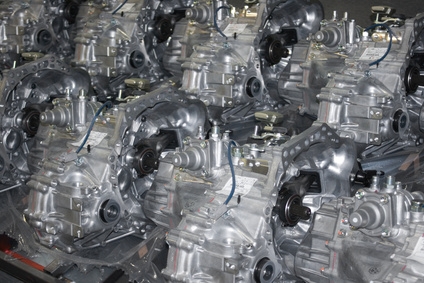
The transmission and torque converter work as a unit to transfer engine combustion energy to the rear wheels. The transmission transfers this energy through a series of graduated gears that start with lower gears and end up with higher gear ratios. A separate reverse gear allows for reverse travel. The torque converter serves as a fluid coupling device between the engine and transmission, allowing a gradual, smooth force of energy, rather than a sudden shock of pressure to the transmission. Both can have their problems; and if you know what to look for, you can avoid costly repairs.
Look for a "check engine" light. If you see one of these, the vehicle will have to be plugged into a code scanner to obtain the exact trouble code. It could reveal that you have a transmission-related problem. Cars equipped with a separate transmission overdrive light will instantly direct you to the culprit.
Use a code scanner to check for all solenoid and sensor readings. Electronic transmissions use speed sensors to send commands for shifting. If they fail or short out, shift patterns can change or leave the transmission in second or third gear as a default setting.
Drive the vehicle using a slow, gradual acceleration. Feel and listen for each individual automatic shift. By the time the vehicle has reached 40 to 50 MPH, the transmission should have reached its top gear without rough shifting or skipping any gears.
Look for any type of transmission fluid leaks in or around the transmission. Check the filler tube base for a seal leak. Check the transmission tail shaft for any seepage and the front of the bell housing that contains the transmission input shaft seals. Any standing fluid on the floor, when the vehicle has sat overnight, can indicate a worn seal or gasket. The transmission pan housing bolts should all be present and tight.
Check the transmission fluid level on the dipstick with a running, warm engine. The level should be topped off at the "Hot" indicator line. If it reads below this line or cannot be seen on the stick, it means additional fluid must be added. Low transmission fluid levels can cause slippage in gear, or the vehicle may not move when put in gear. High-speed slippage occurs when you suddenly push the gas pedal and the vehicle fails to shift, and the engine RPM raises without the transmission engaging.
Examine the transmission fluid. Any fluid that looks muddy, frothy or discolored means that it has become contaminated, and the transmission pump will not function normally. Old fluid or fluid that has become a dirty brown color with a burnt smell to it indicates contaminated fluid.
Listen for the vehicle making any noise while in gear. If the noise disappears after placing the gear selector in neutral, the torque converter needle bearings may be worn, causing excessive movement and misalignment in the parts. The needle bearings separate three major torque converter components; once they have worn, this affects all operational modes of the torque converter.
Shift the vehicle in drive, neutral and then in reverse and listen for any loud clanking or clunking noises. These sounds usually indicate a bad torque converter. This generally occurs when the fluid clutches have become worn or damaged, or indicates a broken mounting bolt or misalignment or a broken mount between the torque converter and the flywheel.
Drive the vehicle and come to a gradual stop, noting any shuddering or stalling. This may point to a bad lockup solenoid, a shorted solenoid or a sticking lockup valve. Lockup shudder can also cause the vehicle to vibrate unnecessarily and indicates a torque converter part that has bent under extreme load or force. Howling or whining noises make come from a defective torque converter or transmission.
Look for any leaking transmission fluid at the drainage hole in the bottom of the bell housing. Cracked torque converters will lose fluid and leak from a small drain inspection hole in this area and might have a burnt smell or dirty brown color.